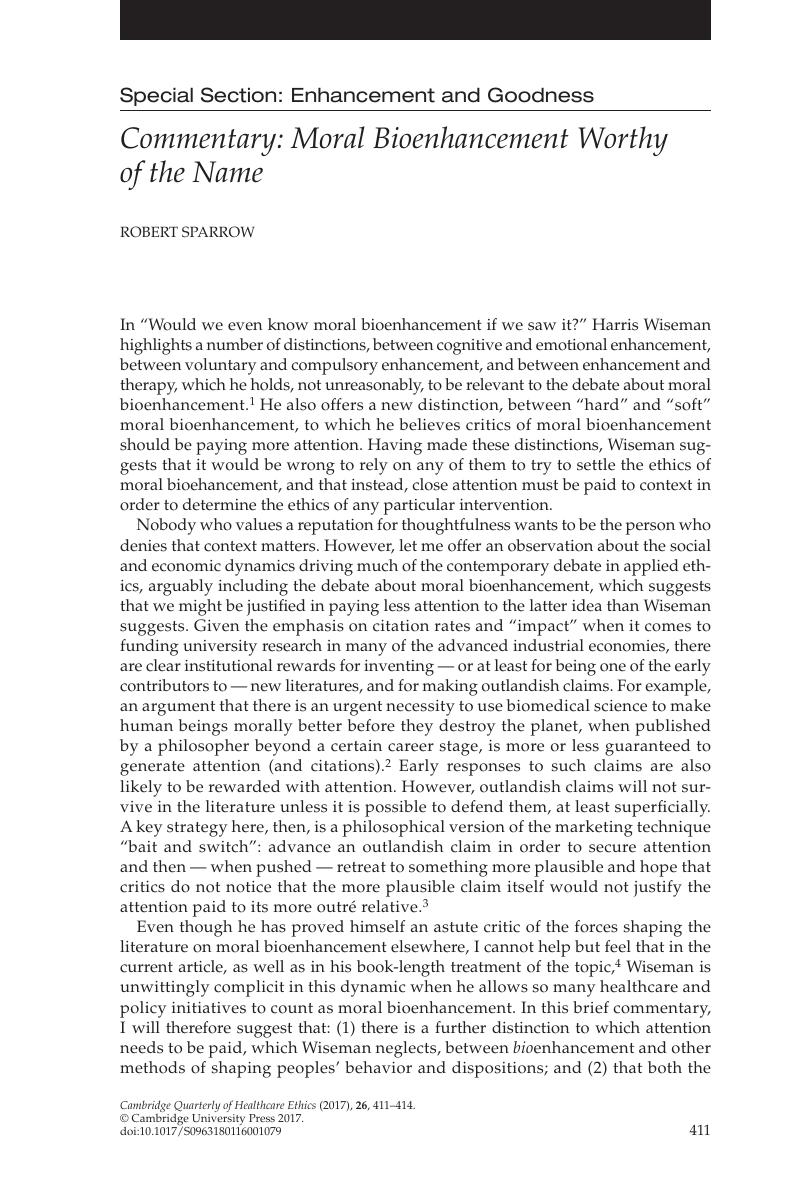Article contents
Commentary: Moral Bioenhancement Worthy of the Name
Published online by Cambridge University Press: 25 May 2017
Abstract

- Type
- Special Section: Enhancement and Goodness
- Information
- Copyright
- Copyright © Cambridge University Press 2017
References
Notes
1. Wiseman H. Would we even know moral bioenhancement if we saw it? Cambridge Quarterly of Healthcare Ethics this issue
2. Persson, I, Savulescu, J. Unfit for the Future: The Need for Moral Enhancement. Oxford: Oxford University Press; 2012.CrossRefGoogle Scholar
3. Sparrow, R. Book review: Beyond humanity? The ethics of biomedical enhancement, by Allen Buchanan. Journal of Applied Philosophy 2012;29(2):160–2CrossRefGoogle Scholar; Sparrow, R. Unfit for the future: The need for moral enhancement, by Persson, Ingmar, and Julian Savulescu. Australasian Journal of Philosophy 2014;92(2):404–7.CrossRefGoogle Scholar
4. Wiseman, H. The Myth of the Moral Brain : The Limits of Moral Enhancement. Cambridge, MA: MIT Press; 2016.CrossRefGoogle Scholar
5. Although Wiseman discusses such policies in a section headed “Issues with Soft Moral Bioenhancement: Paternalism, Social Control, and “Undesirable Behavior’” most of his discussion actually refers to “soft moral enhancement” (my emphasis) suggesting that he too is conscious of the distinction between enhancement and bioenhancement. As I will argue further, even to call such interventions moral enhancement may be a step too far.
6. See note 1, Wiseman 2017.
7. Agar, N. A question about defining moral bioenhancement. Journal of Medical Ethics 2014;40:369–70.CrossRefGoogle ScholarPubMed
8. In passing, there are several aspects of the detail of Wiseman’s account of “hard” bioenhancement that I find unconvincing. Wiseman insists that hard moral bioenhancement could only be voluntary and would necessarily involve an “ongoing predisposition of will.” Although it might well be “political suicide” for a politician (as opposed to, for example, an academic) to call for “compulsory moral bioenhancement for all,” it seems entirely plausible to me that, were candidate technologies to become available, there might be popular support for their coercive application to minority populations or “deviant” individuals, a concern that I know Wiseman shares. Therefore, it is possible that in some cases hard moral bioenhancement might be imposed against the will of the individuals who are thereby enhanced. Moreover, once one admits the possibility of making people more moral at all, as Wiseman does in relation to soft moral bioenhancement, I can see no reason for holding that interventions that are explicitly directed towards individuals’ moral capacities could only be effective if the target continuously wills them to be so.
- 2
- Cited by


